Effective Discharge Plan: Analyzing Kevin Johnson's Case Study
VerifiedAdded on 2023/06/10
|11
|2986
|431
Case Study
AI Summary
This case study examines the effective discharge planning process for Kevin Johnson, a fifteen-year-old patient who sustained multiple injuries from a trail bike accident. The analysis focuses on the key principles of effective discharge planning, including avoiding unnecessary admissions, involving the patient and caregivers, understanding discharge as a process, coordinating multidisciplinary teams, and ensuring continuity of health and social care. The study critically analyzes Kevin's discharge plan, highlighting its strengths in adhering to these principles. It further discusses the nursing process related to activities of daily living impacted by Kevin's injuries and the multidisciplinary team involved in his post-discharge care, including physiotherapists, occupational therapists, wound care specialists, orthopedic surgeons, diabetes educators, pharmacists, and speech pathologists. The conclusion emphasizes the importance of these elements in ensuring a successful patient transition from hospital to home.

Running header: Effective discharge plan. 1
Effective discharge
Institutional affiliation
Course name
Student name
Effective discharge
Institutional affiliation
Course name
Student name
Paraphrase This Document
Need a fresh take? Get an instant paraphrase of this document with our AI Paraphraser
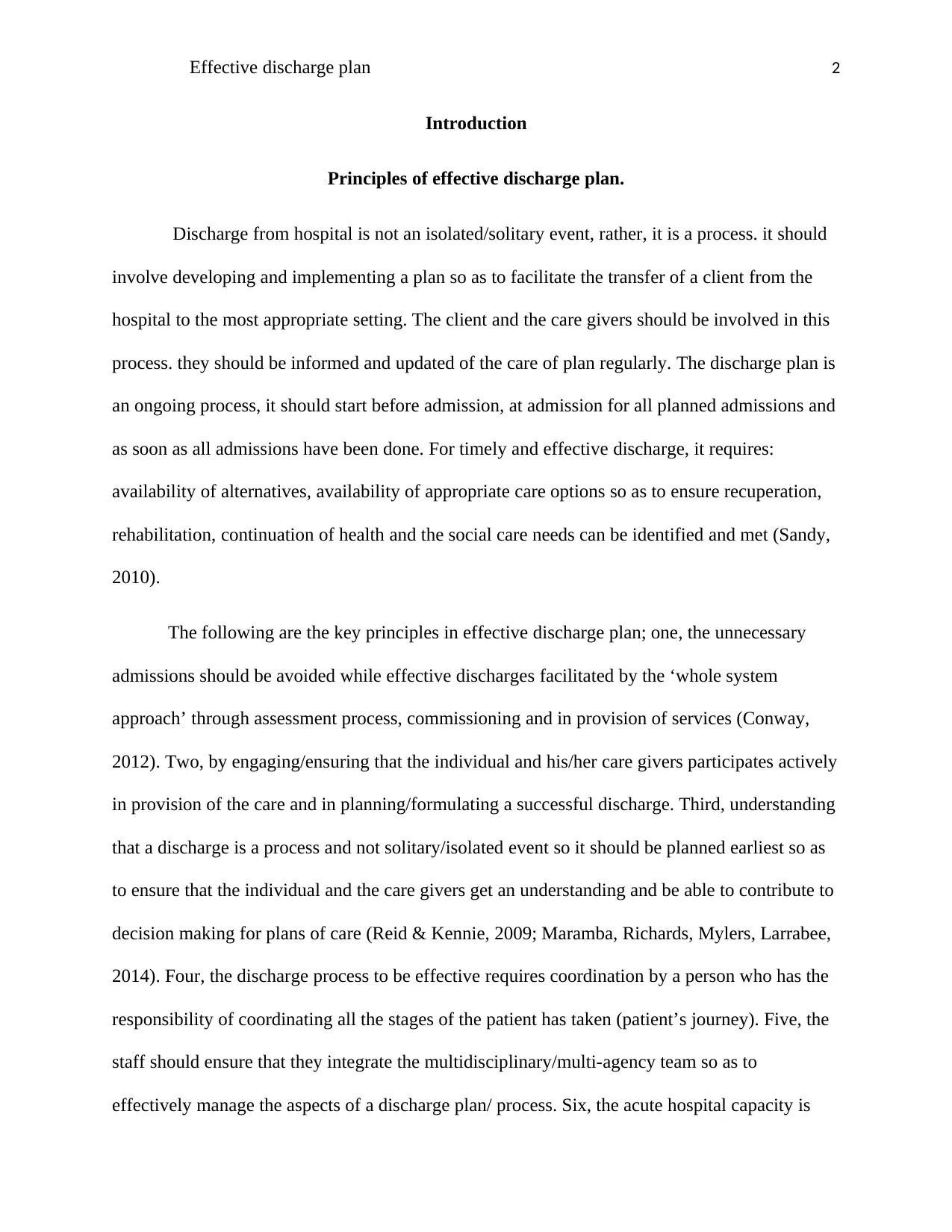
Effective discharge plan 2
Introduction
Principles of effective discharge plan.
Discharge from hospital is not an isolated/solitary event, rather, it is a process. it should
involve developing and implementing a plan so as to facilitate the transfer of a client from the
hospital to the most appropriate setting. The client and the care givers should be involved in this
process. they should be informed and updated of the care of plan regularly. The discharge plan is
an ongoing process, it should start before admission, at admission for all planned admissions and
as soon as all admissions have been done. For timely and effective discharge, it requires:
availability of alternatives, availability of appropriate care options so as to ensure recuperation,
rehabilitation, continuation of health and the social care needs can be identified and met (Sandy,
2010).
The following are the key principles in effective discharge plan; one, the unnecessary
admissions should be avoided while effective discharges facilitated by the ‘whole system
approach’ through assessment process, commissioning and in provision of services (Conway,
2012). Two, by engaging/ensuring that the individual and his/her care givers participates actively
in provision of the care and in planning/formulating a successful discharge. Third, understanding
that a discharge is a process and not solitary/isolated event so it should be planned earliest so as
to ensure that the individual and the care givers get an understanding and be able to contribute to
decision making for plans of care (Reid & Kennie, 2009; Maramba, Richards, Mylers, Larrabee,
2014). Four, the discharge process to be effective requires coordination by a person who has the
responsibility of coordinating all the stages of the patient has taken (patient’s journey). Five, the
staff should ensure that they integrate the multidisciplinary/multi-agency team so as to
effectively manage the aspects of a discharge plan/ process. Six, the acute hospital capacity is
Introduction
Principles of effective discharge plan.
Discharge from hospital is not an isolated/solitary event, rather, it is a process. it should
involve developing and implementing a plan so as to facilitate the transfer of a client from the
hospital to the most appropriate setting. The client and the care givers should be involved in this
process. they should be informed and updated of the care of plan regularly. The discharge plan is
an ongoing process, it should start before admission, at admission for all planned admissions and
as soon as all admissions have been done. For timely and effective discharge, it requires:
availability of alternatives, availability of appropriate care options so as to ensure recuperation,
rehabilitation, continuation of health and the social care needs can be identified and met (Sandy,
2010).
The following are the key principles in effective discharge plan; one, the unnecessary
admissions should be avoided while effective discharges facilitated by the ‘whole system
approach’ through assessment process, commissioning and in provision of services (Conway,
2012). Two, by engaging/ensuring that the individual and his/her care givers participates actively
in provision of the care and in planning/formulating a successful discharge. Third, understanding
that a discharge is a process and not solitary/isolated event so it should be planned earliest so as
to ensure that the individual and the care givers get an understanding and be able to contribute to
decision making for plans of care (Reid & Kennie, 2009; Maramba, Richards, Mylers, Larrabee,
2014). Four, the discharge process to be effective requires coordination by a person who has the
responsibility of coordinating all the stages of the patient has taken (patient’s journey). Five, the
staff should ensure that they integrate the multidisciplinary/multi-agency team so as to
effectively manage the aspects of a discharge plan/ process. Six, the acute hospital capacity is
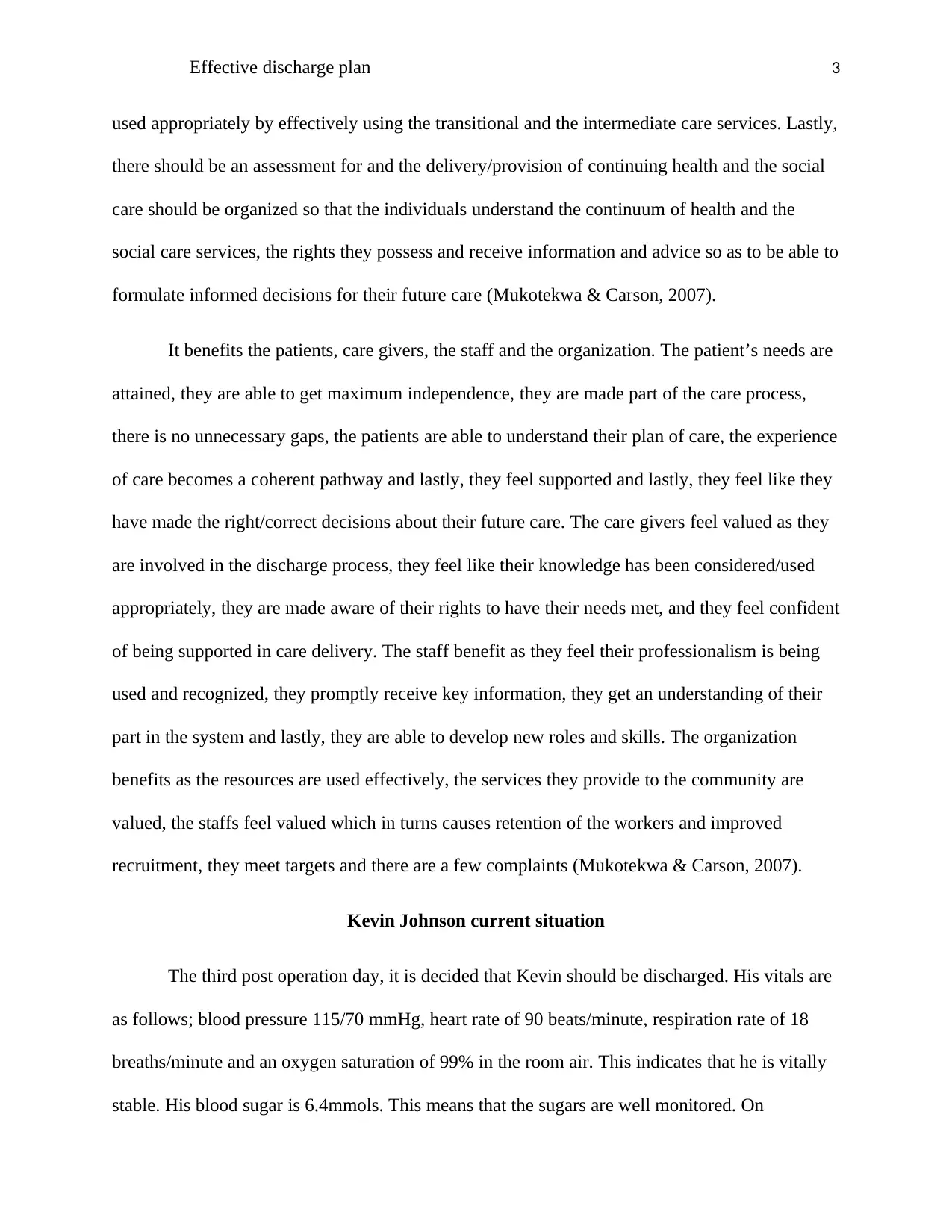
Effective discharge plan 3
used appropriately by effectively using the transitional and the intermediate care services. Lastly,
there should be an assessment for and the delivery/provision of continuing health and the social
care should be organized so that the individuals understand the continuum of health and the
social care services, the rights they possess and receive information and advice so as to be able to
formulate informed decisions for their future care (Mukotekwa & Carson, 2007).
It benefits the patients, care givers, the staff and the organization. The patient’s needs are
attained, they are able to get maximum independence, they are made part of the care process,
there is no unnecessary gaps, the patients are able to understand their plan of care, the experience
of care becomes a coherent pathway and lastly, they feel supported and lastly, they feel like they
have made the right/correct decisions about their future care. The care givers feel valued as they
are involved in the discharge process, they feel like their knowledge has been considered/used
appropriately, they are made aware of their rights to have their needs met, and they feel confident
of being supported in care delivery. The staff benefit as they feel their professionalism is being
used and recognized, they promptly receive key information, they get an understanding of their
part in the system and lastly, they are able to develop new roles and skills. The organization
benefits as the resources are used effectively, the services they provide to the community are
valued, the staffs feel valued which in turns causes retention of the workers and improved
recruitment, they meet targets and there are a few complaints (Mukotekwa & Carson, 2007).
Kevin Johnson current situation
The third post operation day, it is decided that Kevin should be discharged. His vitals are
as follows; blood pressure 115/70 mmHg, heart rate of 90 beats/minute, respiration rate of 18
breaths/minute and an oxygen saturation of 99% in the room air. This indicates that he is vitally
stable. His blood sugar is 6.4mmols. This means that the sugars are well monitored. On
used appropriately by effectively using the transitional and the intermediate care services. Lastly,
there should be an assessment for and the delivery/provision of continuing health and the social
care should be organized so that the individuals understand the continuum of health and the
social care services, the rights they possess and receive information and advice so as to be able to
formulate informed decisions for their future care (Mukotekwa & Carson, 2007).
It benefits the patients, care givers, the staff and the organization. The patient’s needs are
attained, they are able to get maximum independence, they are made part of the care process,
there is no unnecessary gaps, the patients are able to understand their plan of care, the experience
of care becomes a coherent pathway and lastly, they feel supported and lastly, they feel like they
have made the right/correct decisions about their future care. The care givers feel valued as they
are involved in the discharge process, they feel like their knowledge has been considered/used
appropriately, they are made aware of their rights to have their needs met, and they feel confident
of being supported in care delivery. The staff benefit as they feel their professionalism is being
used and recognized, they promptly receive key information, they get an understanding of their
part in the system and lastly, they are able to develop new roles and skills. The organization
benefits as the resources are used effectively, the services they provide to the community are
valued, the staffs feel valued which in turns causes retention of the workers and improved
recruitment, they meet targets and there are a few complaints (Mukotekwa & Carson, 2007).
Kevin Johnson current situation
The third post operation day, it is decided that Kevin should be discharged. His vitals are
as follows; blood pressure 115/70 mmHg, heart rate of 90 beats/minute, respiration rate of 18
breaths/minute and an oxygen saturation of 99% in the room air. This indicates that he is vitally
stable. His blood sugar is 6.4mmols. This means that the sugars are well monitored. On
⊘ This is a preview!⊘
Do you want full access?
Subscribe today to unlock all pages.

Trusted by 1+ million students worldwide
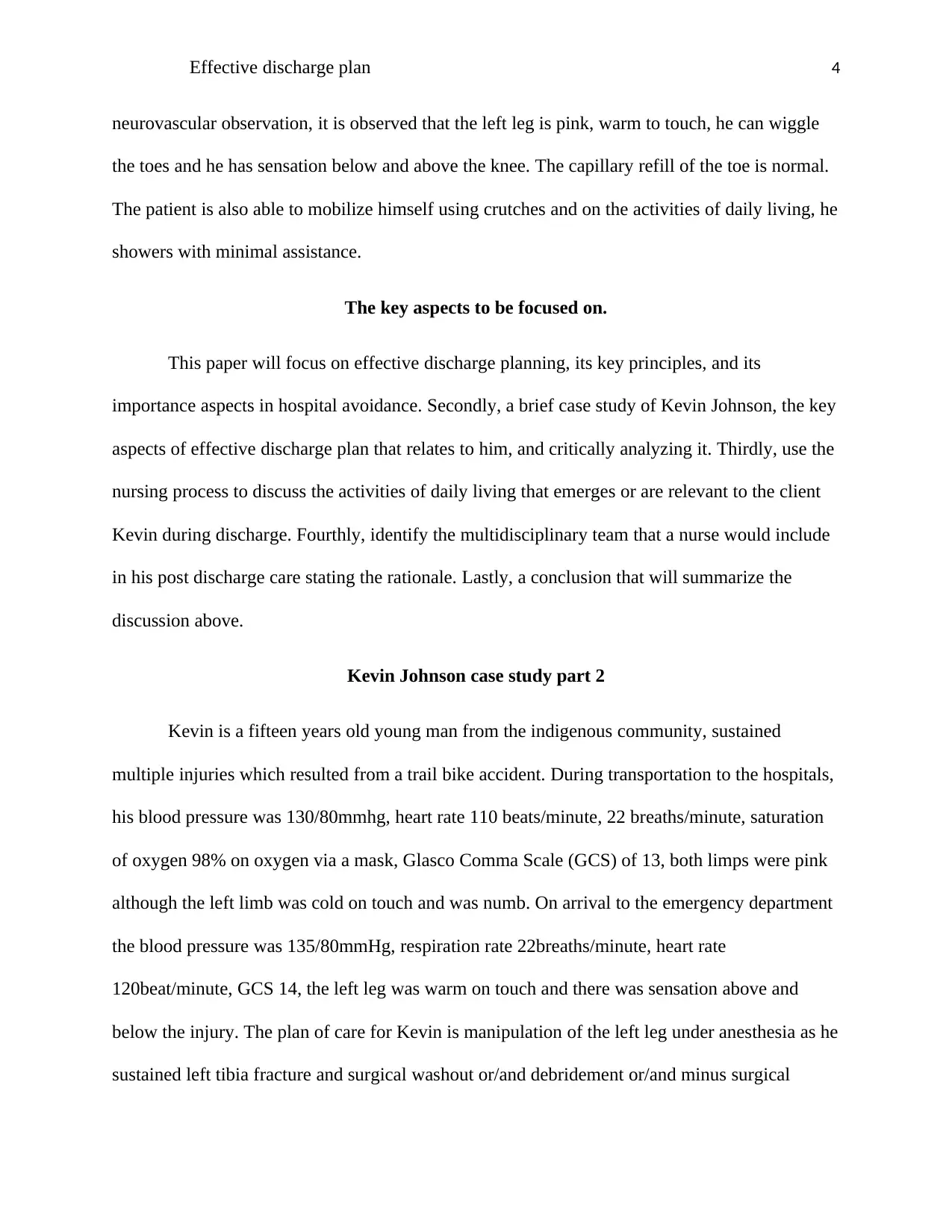
Effective discharge plan 4
neurovascular observation, it is observed that the left leg is pink, warm to touch, he can wiggle
the toes and he has sensation below and above the knee. The capillary refill of the toe is normal.
The patient is also able to mobilize himself using crutches and on the activities of daily living, he
showers with minimal assistance.
The key aspects to be focused on.
This paper will focus on effective discharge planning, its key principles, and its
importance aspects in hospital avoidance. Secondly, a brief case study of Kevin Johnson, the key
aspects of effective discharge plan that relates to him, and critically analyzing it. Thirdly, use the
nursing process to discuss the activities of daily living that emerges or are relevant to the client
Kevin during discharge. Fourthly, identify the multidisciplinary team that a nurse would include
in his post discharge care stating the rationale. Lastly, a conclusion that will summarize the
discussion above.
Kevin Johnson case study part 2
Kevin is a fifteen years old young man from the indigenous community, sustained
multiple injuries which resulted from a trail bike accident. During transportation to the hospitals,
his blood pressure was 130/80mmhg, heart rate 110 beats/minute, 22 breaths/minute, saturation
of oxygen 98% on oxygen via a mask, Glasco Comma Scale (GCS) of 13, both limps were pink
although the left limb was cold on touch and was numb. On arrival to the emergency department
the blood pressure was 135/80mmHg, respiration rate 22breaths/minute, heart rate
120beat/minute, GCS 14, the left leg was warm on touch and there was sensation above and
below the injury. The plan of care for Kevin is manipulation of the left leg under anesthesia as he
sustained left tibia fracture and surgical washout or/and debridement or/and minus surgical
neurovascular observation, it is observed that the left leg is pink, warm to touch, he can wiggle
the toes and he has sensation below and above the knee. The capillary refill of the toe is normal.
The patient is also able to mobilize himself using crutches and on the activities of daily living, he
showers with minimal assistance.
The key aspects to be focused on.
This paper will focus on effective discharge planning, its key principles, and its
importance aspects in hospital avoidance. Secondly, a brief case study of Kevin Johnson, the key
aspects of effective discharge plan that relates to him, and critically analyzing it. Thirdly, use the
nursing process to discuss the activities of daily living that emerges or are relevant to the client
Kevin during discharge. Fourthly, identify the multidisciplinary team that a nurse would include
in his post discharge care stating the rationale. Lastly, a conclusion that will summarize the
discussion above.
Kevin Johnson case study part 2
Kevin is a fifteen years old young man from the indigenous community, sustained
multiple injuries which resulted from a trail bike accident. During transportation to the hospitals,
his blood pressure was 130/80mmhg, heart rate 110 beats/minute, 22 breaths/minute, saturation
of oxygen 98% on oxygen via a mask, Glasco Comma Scale (GCS) of 13, both limps were pink
although the left limb was cold on touch and was numb. On arrival to the emergency department
the blood pressure was 135/80mmHg, respiration rate 22breaths/minute, heart rate
120beat/minute, GCS 14, the left leg was warm on touch and there was sensation above and
below the injury. The plan of care for Kevin is manipulation of the left leg under anesthesia as he
sustained left tibia fracture and surgical washout or/and debridement or/and minus surgical
Paraphrase This Document
Need a fresh take? Get an instant paraphrase of this document with our AI Paraphraser
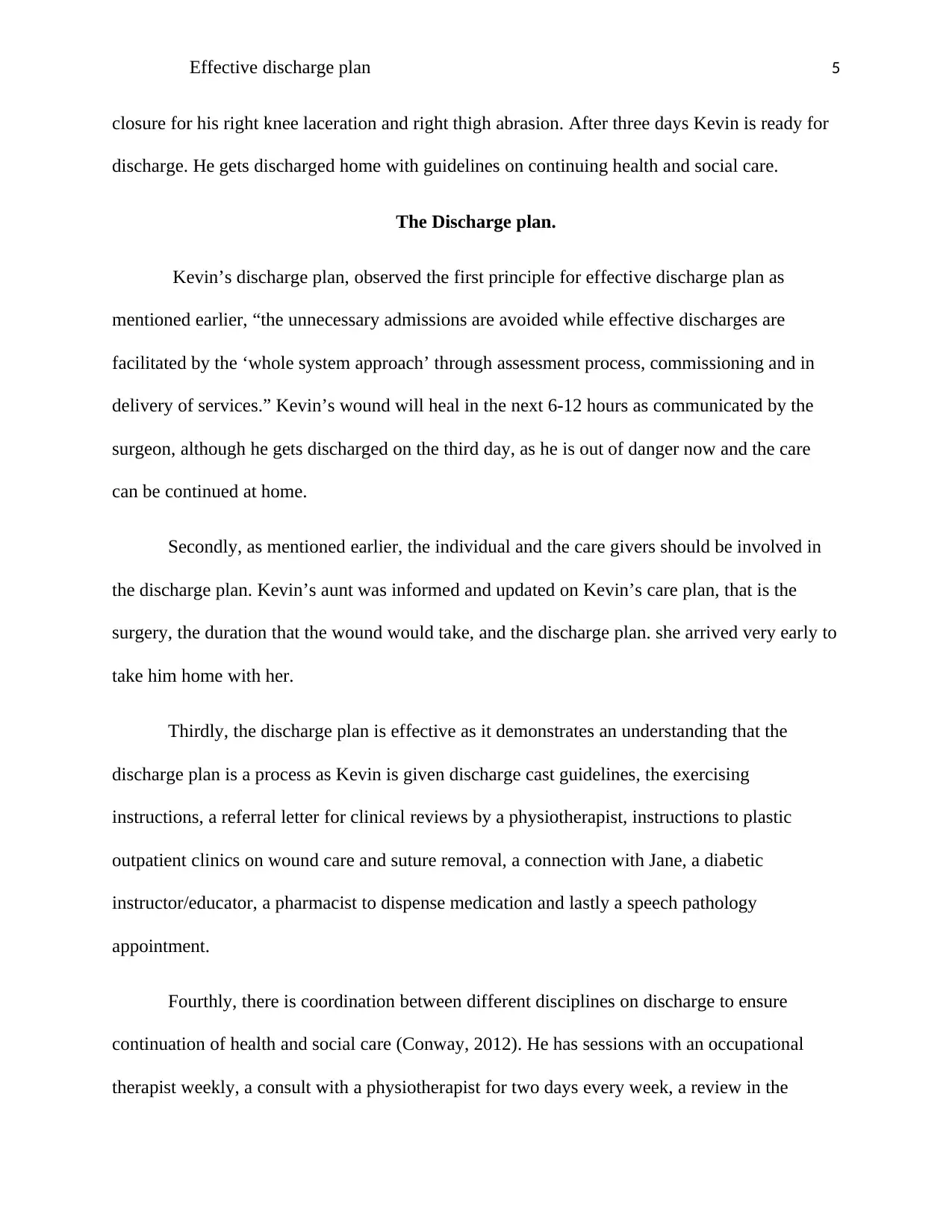
Effective discharge plan 5
closure for his right knee laceration and right thigh abrasion. After three days Kevin is ready for
discharge. He gets discharged home with guidelines on continuing health and social care.
The Discharge plan.
Kevin’s discharge plan, observed the first principle for effective discharge plan as
mentioned earlier, “the unnecessary admissions are avoided while effective discharges are
facilitated by the ‘whole system approach’ through assessment process, commissioning and in
delivery of services.” Kevin’s wound will heal in the next 6-12 hours as communicated by the
surgeon, although he gets discharged on the third day, as he is out of danger now and the care
can be continued at home.
Secondly, as mentioned earlier, the individual and the care givers should be involved in
the discharge plan. Kevin’s aunt was informed and updated on Kevin’s care plan, that is the
surgery, the duration that the wound would take, and the discharge plan. she arrived very early to
take him home with her.
Thirdly, the discharge plan is effective as it demonstrates an understanding that the
discharge plan is a process as Kevin is given discharge cast guidelines, the exercising
instructions, a referral letter for clinical reviews by a physiotherapist, instructions to plastic
outpatient clinics on wound care and suture removal, a connection with Jane, a diabetic
instructor/educator, a pharmacist to dispense medication and lastly a speech pathology
appointment.
Fourthly, there is coordination between different disciplines on discharge to ensure
continuation of health and social care (Conway, 2012). He has sessions with an occupational
therapist weekly, a consult with a physiotherapist for two days every week, a review in the
closure for his right knee laceration and right thigh abrasion. After three days Kevin is ready for
discharge. He gets discharged home with guidelines on continuing health and social care.
The Discharge plan.
Kevin’s discharge plan, observed the first principle for effective discharge plan as
mentioned earlier, “the unnecessary admissions are avoided while effective discharges are
facilitated by the ‘whole system approach’ through assessment process, commissioning and in
delivery of services.” Kevin’s wound will heal in the next 6-12 hours as communicated by the
surgeon, although he gets discharged on the third day, as he is out of danger now and the care
can be continued at home.
Secondly, as mentioned earlier, the individual and the care givers should be involved in
the discharge plan. Kevin’s aunt was informed and updated on Kevin’s care plan, that is the
surgery, the duration that the wound would take, and the discharge plan. she arrived very early to
take him home with her.
Thirdly, the discharge plan is effective as it demonstrates an understanding that the
discharge plan is a process as Kevin is given discharge cast guidelines, the exercising
instructions, a referral letter for clinical reviews by a physiotherapist, instructions to plastic
outpatient clinics on wound care and suture removal, a connection with Jane, a diabetic
instructor/educator, a pharmacist to dispense medication and lastly a speech pathology
appointment.
Fourthly, there is coordination between different disciplines on discharge to ensure
continuation of health and social care (Conway, 2012). He has sessions with an occupational
therapist weekly, a consult with a physiotherapist for two days every week, a review in the
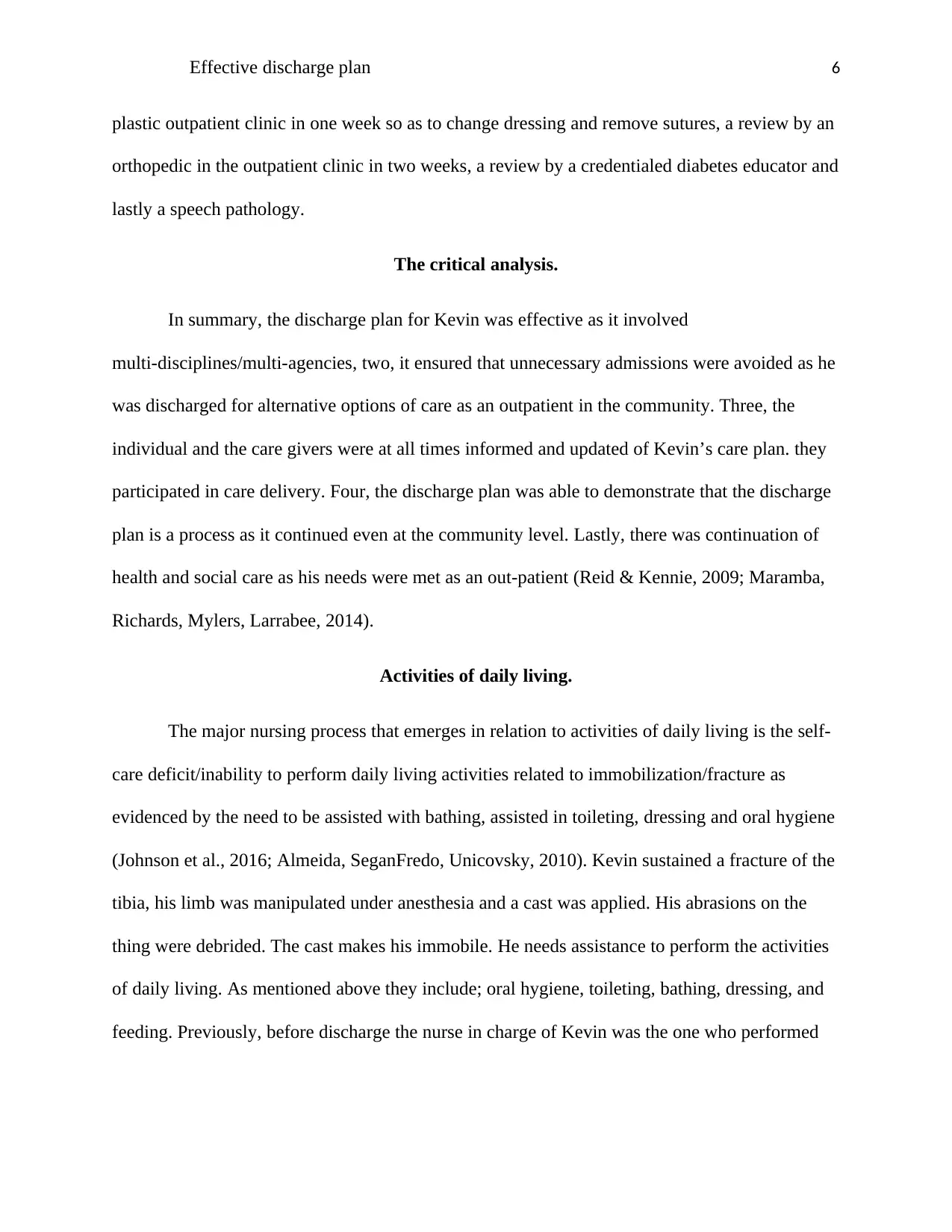
Effective discharge plan 6
plastic outpatient clinic in one week so as to change dressing and remove sutures, a review by an
orthopedic in the outpatient clinic in two weeks, a review by a credentialed diabetes educator and
lastly a speech pathology.
The critical analysis.
In summary, the discharge plan for Kevin was effective as it involved
multi-disciplines/multi-agencies, two, it ensured that unnecessary admissions were avoided as he
was discharged for alternative options of care as an outpatient in the community. Three, the
individual and the care givers were at all times informed and updated of Kevin’s care plan. they
participated in care delivery. Four, the discharge plan was able to demonstrate that the discharge
plan is a process as it continued even at the community level. Lastly, there was continuation of
health and social care as his needs were met as an out-patient (Reid & Kennie, 2009; Maramba,
Richards, Mylers, Larrabee, 2014).
Activities of daily living.
The major nursing process that emerges in relation to activities of daily living is the self-
care deficit/inability to perform daily living activities related to immobilization/fracture as
evidenced by the need to be assisted with bathing, assisted in toileting, dressing and oral hygiene
(Johnson et al., 2016; Almeida, SeganFredo, Unicovsky, 2010). Kevin sustained a fracture of the
tibia, his limb was manipulated under anesthesia and a cast was applied. His abrasions on the
thing were debrided. The cast makes his immobile. He needs assistance to perform the activities
of daily living. As mentioned above they include; oral hygiene, toileting, bathing, dressing, and
feeding. Previously, before discharge the nurse in charge of Kevin was the one who performed
plastic outpatient clinic in one week so as to change dressing and remove sutures, a review by an
orthopedic in the outpatient clinic in two weeks, a review by a credentialed diabetes educator and
lastly a speech pathology.
The critical analysis.
In summary, the discharge plan for Kevin was effective as it involved
multi-disciplines/multi-agencies, two, it ensured that unnecessary admissions were avoided as he
was discharged for alternative options of care as an outpatient in the community. Three, the
individual and the care givers were at all times informed and updated of Kevin’s care plan. they
participated in care delivery. Four, the discharge plan was able to demonstrate that the discharge
plan is a process as it continued even at the community level. Lastly, there was continuation of
health and social care as his needs were met as an out-patient (Reid & Kennie, 2009; Maramba,
Richards, Mylers, Larrabee, 2014).
Activities of daily living.
The major nursing process that emerges in relation to activities of daily living is the self-
care deficit/inability to perform daily living activities related to immobilization/fracture as
evidenced by the need to be assisted with bathing, assisted in toileting, dressing and oral hygiene
(Johnson et al., 2016; Almeida, SeganFredo, Unicovsky, 2010). Kevin sustained a fracture of the
tibia, his limb was manipulated under anesthesia and a cast was applied. His abrasions on the
thing were debrided. The cast makes his immobile. He needs assistance to perform the activities
of daily living. As mentioned above they include; oral hygiene, toileting, bathing, dressing, and
feeding. Previously, before discharge the nurse in charge of Kevin was the one who performed
⊘ This is a preview!⊘
Do you want full access?
Subscribe today to unlock all pages.

Trusted by 1+ million students worldwide
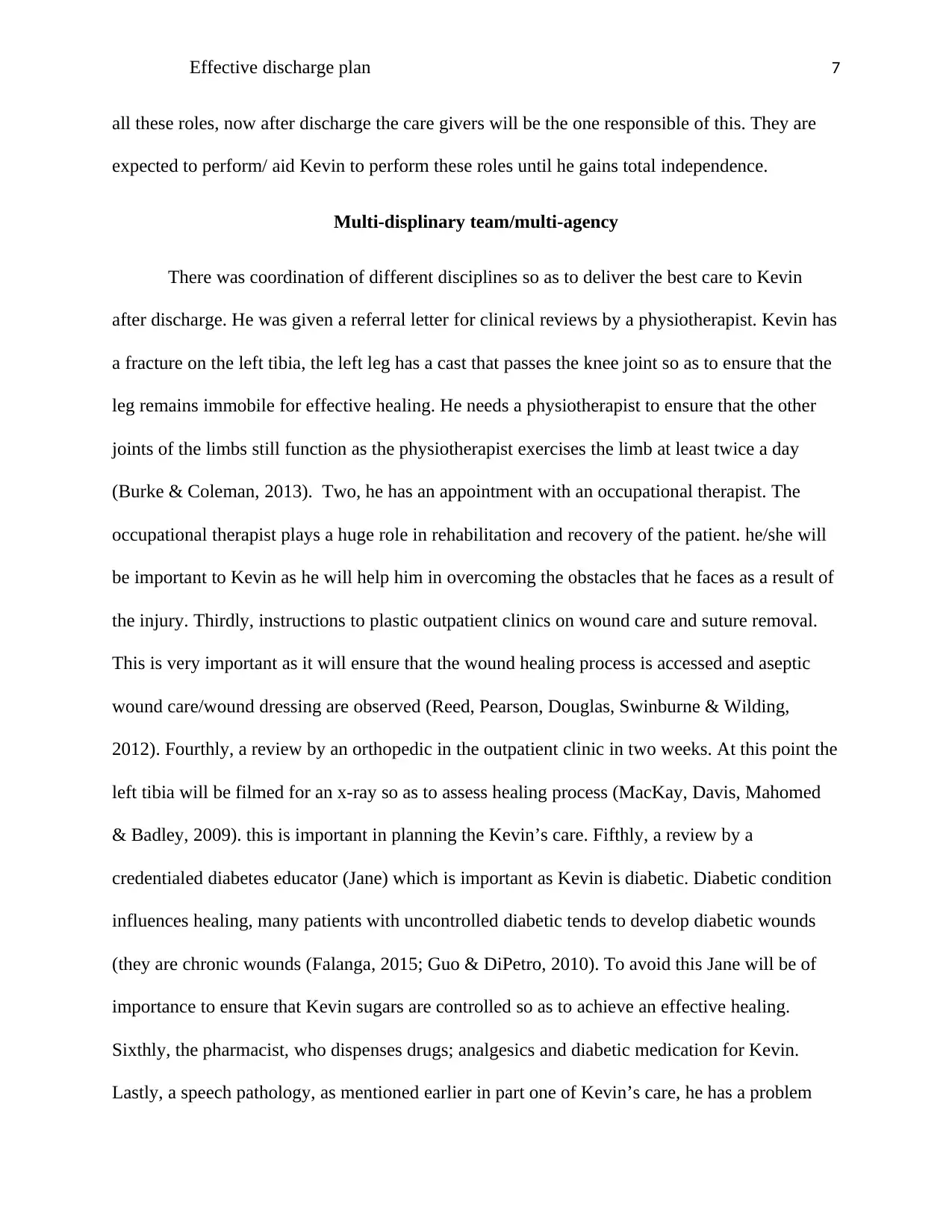
Effective discharge plan 7
all these roles, now after discharge the care givers will be the one responsible of this. They are
expected to perform/ aid Kevin to perform these roles until he gains total independence.
Multi-displinary team/multi-agency
There was coordination of different disciplines so as to deliver the best care to Kevin
after discharge. He was given a referral letter for clinical reviews by a physiotherapist. Kevin has
a fracture on the left tibia, the left leg has a cast that passes the knee joint so as to ensure that the
leg remains immobile for effective healing. He needs a physiotherapist to ensure that the other
joints of the limbs still function as the physiotherapist exercises the limb at least twice a day
(Burke & Coleman, 2013). Two, he has an appointment with an occupational therapist. The
occupational therapist plays a huge role in rehabilitation and recovery of the patient. he/she will
be important to Kevin as he will help him in overcoming the obstacles that he faces as a result of
the injury. Thirdly, instructions to plastic outpatient clinics on wound care and suture removal.
This is very important as it will ensure that the wound healing process is accessed and aseptic
wound care/wound dressing are observed (Reed, Pearson, Douglas, Swinburne & Wilding,
2012). Fourthly, a review by an orthopedic in the outpatient clinic in two weeks. At this point the
left tibia will be filmed for an x-ray so as to assess healing process (MacKay, Davis, Mahomed
& Badley, 2009). this is important in planning the Kevin’s care. Fifthly, a review by a
credentialed diabetes educator (Jane) which is important as Kevin is diabetic. Diabetic condition
influences healing, many patients with uncontrolled diabetic tends to develop diabetic wounds
(they are chronic wounds (Falanga, 2015; Guo & DiPetro, 2010). To avoid this Jane will be of
importance to ensure that Kevin sugars are controlled so as to achieve an effective healing.
Sixthly, the pharmacist, who dispenses drugs; analgesics and diabetic medication for Kevin.
Lastly, a speech pathology, as mentioned earlier in part one of Kevin’s care, he has a problem
all these roles, now after discharge the care givers will be the one responsible of this. They are
expected to perform/ aid Kevin to perform these roles until he gains total independence.
Multi-displinary team/multi-agency
There was coordination of different disciplines so as to deliver the best care to Kevin
after discharge. He was given a referral letter for clinical reviews by a physiotherapist. Kevin has
a fracture on the left tibia, the left leg has a cast that passes the knee joint so as to ensure that the
leg remains immobile for effective healing. He needs a physiotherapist to ensure that the other
joints of the limbs still function as the physiotherapist exercises the limb at least twice a day
(Burke & Coleman, 2013). Two, he has an appointment with an occupational therapist. The
occupational therapist plays a huge role in rehabilitation and recovery of the patient. he/she will
be important to Kevin as he will help him in overcoming the obstacles that he faces as a result of
the injury. Thirdly, instructions to plastic outpatient clinics on wound care and suture removal.
This is very important as it will ensure that the wound healing process is accessed and aseptic
wound care/wound dressing are observed (Reed, Pearson, Douglas, Swinburne & Wilding,
2012). Fourthly, a review by an orthopedic in the outpatient clinic in two weeks. At this point the
left tibia will be filmed for an x-ray so as to assess healing process (MacKay, Davis, Mahomed
& Badley, 2009). this is important in planning the Kevin’s care. Fifthly, a review by a
credentialed diabetes educator (Jane) which is important as Kevin is diabetic. Diabetic condition
influences healing, many patients with uncontrolled diabetic tends to develop diabetic wounds
(they are chronic wounds (Falanga, 2015; Guo & DiPetro, 2010). To avoid this Jane will be of
importance to ensure that Kevin sugars are controlled so as to achieve an effective healing.
Sixthly, the pharmacist, who dispenses drugs; analgesics and diabetic medication for Kevin.
Lastly, a speech pathology, as mentioned earlier in part one of Kevin’s care, he has a problem
Paraphrase This Document
Need a fresh take? Get an instant paraphrase of this document with our AI Paraphraser
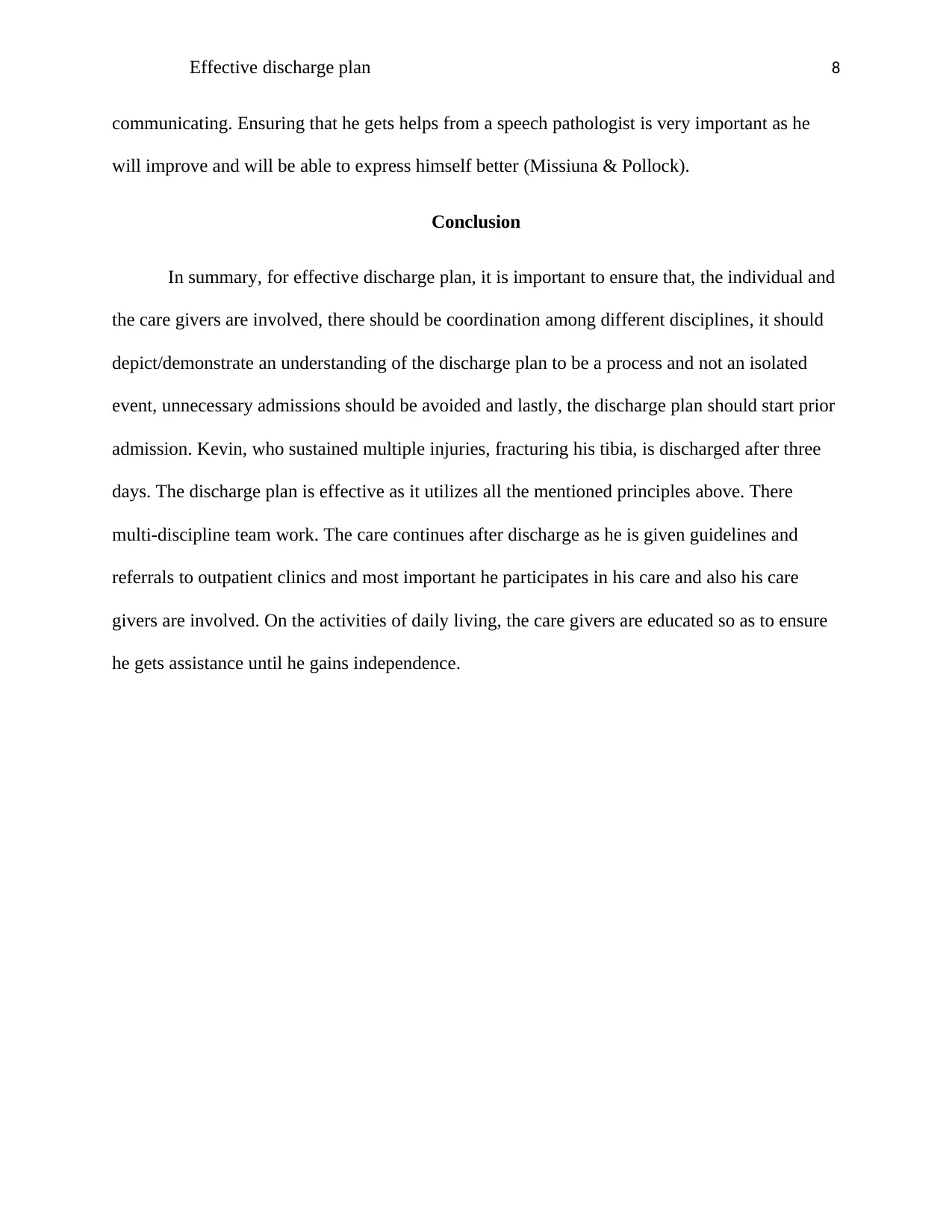
Effective discharge plan 8
communicating. Ensuring that he gets helps from a speech pathologist is very important as he
will improve and will be able to express himself better (Missiuna & Pollock).
Conclusion
In summary, for effective discharge plan, it is important to ensure that, the individual and
the care givers are involved, there should be coordination among different disciplines, it should
depict/demonstrate an understanding of the discharge plan to be a process and not an isolated
event, unnecessary admissions should be avoided and lastly, the discharge plan should start prior
admission. Kevin, who sustained multiple injuries, fracturing his tibia, is discharged after three
days. The discharge plan is effective as it utilizes all the mentioned principles above. There
multi-discipline team work. The care continues after discharge as he is given guidelines and
referrals to outpatient clinics and most important he participates in his care and also his care
givers are involved. On the activities of daily living, the care givers are educated so as to ensure
he gets assistance until he gains independence.
communicating. Ensuring that he gets helps from a speech pathologist is very important as he
will improve and will be able to express himself better (Missiuna & Pollock).
Conclusion
In summary, for effective discharge plan, it is important to ensure that, the individual and
the care givers are involved, there should be coordination among different disciplines, it should
depict/demonstrate an understanding of the discharge plan to be a process and not an isolated
event, unnecessary admissions should be avoided and lastly, the discharge plan should start prior
admission. Kevin, who sustained multiple injuries, fracturing his tibia, is discharged after three
days. The discharge plan is effective as it utilizes all the mentioned principles above. There
multi-discipline team work. The care continues after discharge as he is given guidelines and
referrals to outpatient clinics and most important he participates in his care and also his care
givers are involved. On the activities of daily living, the care givers are educated so as to ensure
he gets assistance until he gains independence.
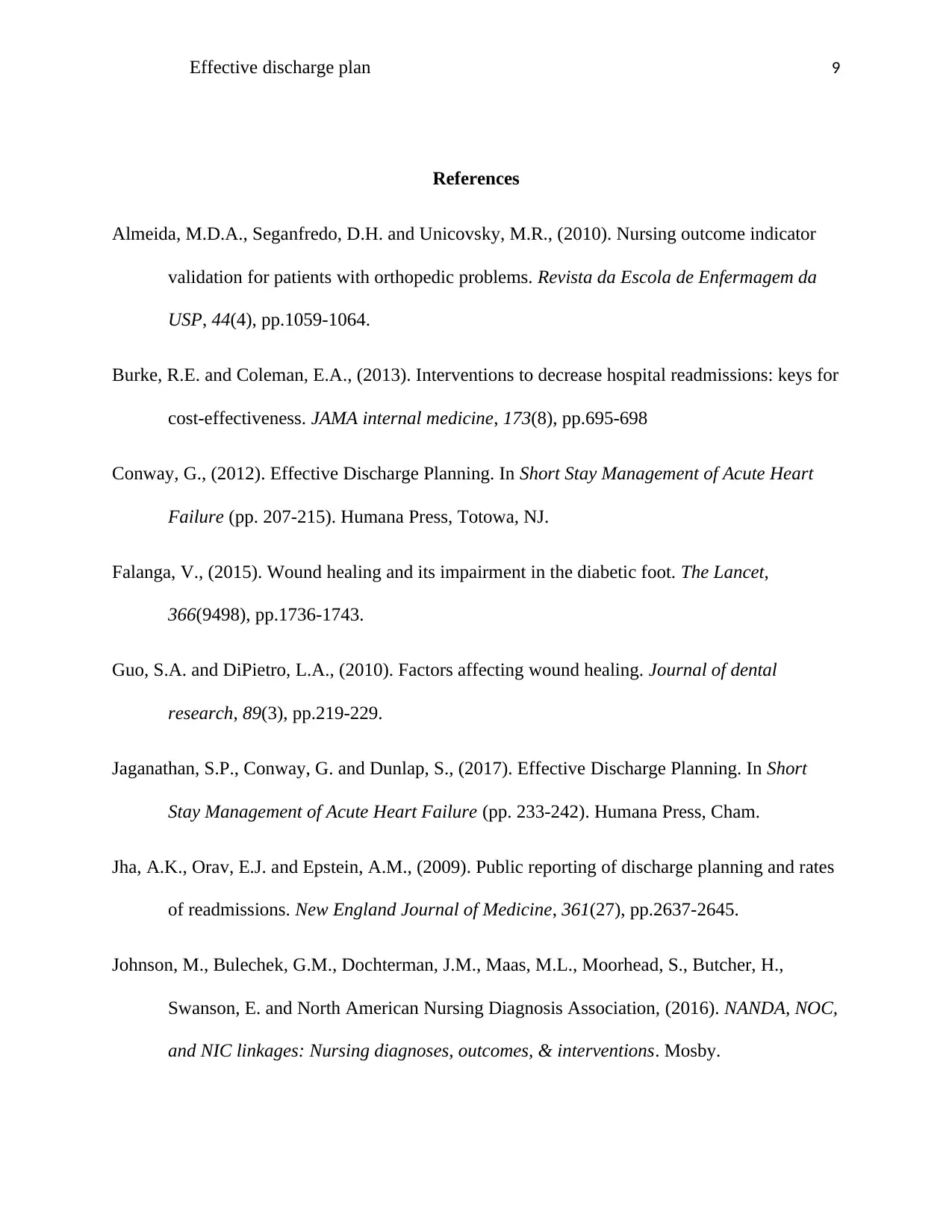
Effective discharge plan 9
References
Almeida, M.D.A., Seganfredo, D.H. and Unicovsky, M.R., (2010). Nursing outcome indicator
validation for patients with orthopedic problems. Revista da Escola de Enfermagem da
USP, 44(4), pp.1059-1064.
Burke, R.E. and Coleman, E.A., (2013). Interventions to decrease hospital readmissions: keys for
cost-effectiveness. JAMA internal medicine, 173(8), pp.695-698
Conway, G., (2012). Effective Discharge Planning. In Short Stay Management of Acute Heart
Failure (pp. 207-215). Humana Press, Totowa, NJ.
Falanga, V., (2015). Wound healing and its impairment in the diabetic foot. The Lancet,
366(9498), pp.1736-1743.
Guo, S.A. and DiPietro, L.A., (2010). Factors affecting wound healing. Journal of dental
research, 89(3), pp.219-229.
Jaganathan, S.P., Conway, G. and Dunlap, S., (2017). Effective Discharge Planning. In Short
Stay Management of Acute Heart Failure (pp. 233-242). Humana Press, Cham.
Jha, A.K., Orav, E.J. and Epstein, A.M., (2009). Public reporting of discharge planning and rates
of readmissions. New England Journal of Medicine, 361(27), pp.2637-2645.
Johnson, M., Bulechek, G.M., Dochterman, J.M., Maas, M.L., Moorhead, S., Butcher, H.,
Swanson, E. and North American Nursing Diagnosis Association, (2016). NANDA, NOC,
and NIC linkages: Nursing diagnoses, outcomes, & interventions. Mosby.
References
Almeida, M.D.A., Seganfredo, D.H. and Unicovsky, M.R., (2010). Nursing outcome indicator
validation for patients with orthopedic problems. Revista da Escola de Enfermagem da
USP, 44(4), pp.1059-1064.
Burke, R.E. and Coleman, E.A., (2013). Interventions to decrease hospital readmissions: keys for
cost-effectiveness. JAMA internal medicine, 173(8), pp.695-698
Conway, G., (2012). Effective Discharge Planning. In Short Stay Management of Acute Heart
Failure (pp. 207-215). Humana Press, Totowa, NJ.
Falanga, V., (2015). Wound healing and its impairment in the diabetic foot. The Lancet,
366(9498), pp.1736-1743.
Guo, S.A. and DiPietro, L.A., (2010). Factors affecting wound healing. Journal of dental
research, 89(3), pp.219-229.
Jaganathan, S.P., Conway, G. and Dunlap, S., (2017). Effective Discharge Planning. In Short
Stay Management of Acute Heart Failure (pp. 233-242). Humana Press, Cham.
Jha, A.K., Orav, E.J. and Epstein, A.M., (2009). Public reporting of discharge planning and rates
of readmissions. New England Journal of Medicine, 361(27), pp.2637-2645.
Johnson, M., Bulechek, G.M., Dochterman, J.M., Maas, M.L., Moorhead, S., Butcher, H.,
Swanson, E. and North American Nursing Diagnosis Association, (2016). NANDA, NOC,
and NIC linkages: Nursing diagnoses, outcomes, & interventions. Mosby.
⊘ This is a preview!⊘
Do you want full access?
Subscribe today to unlock all pages.

Trusted by 1+ million students worldwide
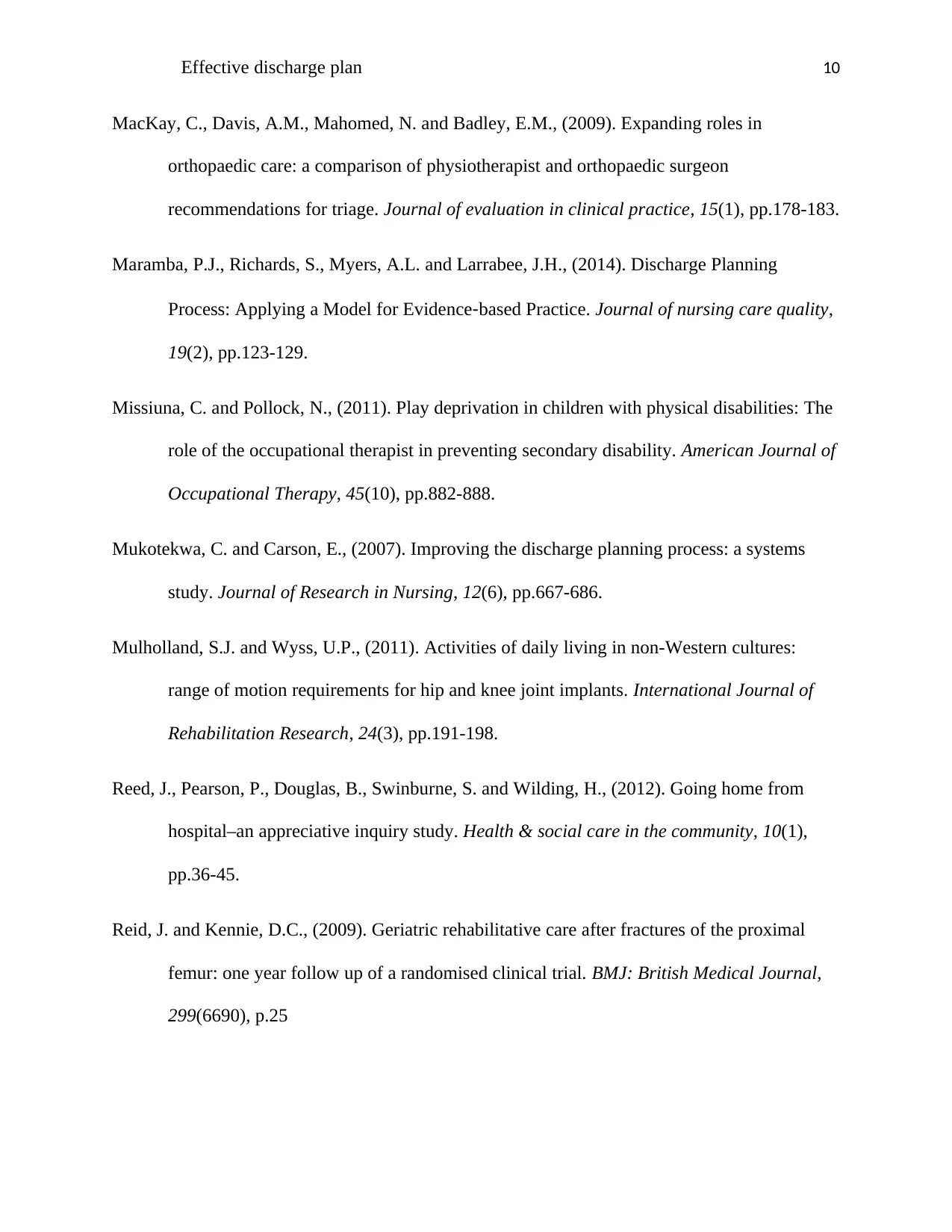
Effective discharge plan 10
MacKay, C., Davis, A.M., Mahomed, N. and Badley, E.M., (2009). Expanding roles in
orthopaedic care: a comparison of physiotherapist and orthopaedic surgeon
recommendations for triage. Journal of evaluation in clinical practice, 15(1), pp.178-183.
Maramba, P.J., Richards, S., Myers, A.L. and Larrabee, J.H., (2014). Discharge Planning
Process: Applying a Model for Evidence‐based Practice. Journal of nursing care quality,
19(2), pp.123-129.
Missiuna, C. and Pollock, N., (2011). Play deprivation in children with physical disabilities: The
role of the occupational therapist in preventing secondary disability. American Journal of
Occupational Therapy, 45(10), pp.882-888.
Mukotekwa, C. and Carson, E., (2007). Improving the discharge planning process: a systems
study. Journal of Research in Nursing, 12(6), pp.667-686.
Mulholland, S.J. and Wyss, U.P., (2011). Activities of daily living in non-Western cultures:
range of motion requirements for hip and knee joint implants. International Journal of
Rehabilitation Research, 24(3), pp.191-198.
Reed, J., Pearson, P., Douglas, B., Swinburne, S. and Wilding, H., (2012). Going home from
hospital–an appreciative inquiry study. Health & social care in the community, 10(1),
pp.36-45.
Reid, J. and Kennie, D.C., (2009). Geriatric rehabilitative care after fractures of the proximal
femur: one year follow up of a randomised clinical trial. BMJ: British Medical Journal,
299(6690), p.25
MacKay, C., Davis, A.M., Mahomed, N. and Badley, E.M., (2009). Expanding roles in
orthopaedic care: a comparison of physiotherapist and orthopaedic surgeon
recommendations for triage. Journal of evaluation in clinical practice, 15(1), pp.178-183.
Maramba, P.J., Richards, S., Myers, A.L. and Larrabee, J.H., (2014). Discharge Planning
Process: Applying a Model for Evidence‐based Practice. Journal of nursing care quality,
19(2), pp.123-129.
Missiuna, C. and Pollock, N., (2011). Play deprivation in children with physical disabilities: The
role of the occupational therapist in preventing secondary disability. American Journal of
Occupational Therapy, 45(10), pp.882-888.
Mukotekwa, C. and Carson, E., (2007). Improving the discharge planning process: a systems
study. Journal of Research in Nursing, 12(6), pp.667-686.
Mulholland, S.J. and Wyss, U.P., (2011). Activities of daily living in non-Western cultures:
range of motion requirements for hip and knee joint implants. International Journal of
Rehabilitation Research, 24(3), pp.191-198.
Reed, J., Pearson, P., Douglas, B., Swinburne, S. and Wilding, H., (2012). Going home from
hospital–an appreciative inquiry study. Health & social care in the community, 10(1),
pp.36-45.
Reid, J. and Kennie, D.C., (2009). Geriatric rehabilitative care after fractures of the proximal
femur: one year follow up of a randomised clinical trial. BMJ: British Medical Journal,
299(6690), p.25
Paraphrase This Document
Need a fresh take? Get an instant paraphrase of this document with our AI Paraphraser

Effective discharge plan 11
Sandy, L.P., (2010). Case management in the emergency room. Professional case management,
15(2), pp.111-113.
Sandy, L.P., (2010). Case management in the emergency room. Professional case management,
15(2), pp.111-113.
1 out of 11
Related Documents
Your All-in-One AI-Powered Toolkit for Academic Success.
+13062052269
info@desklib.com
Available 24*7 on WhatsApp / Email
![[object Object]](/_next/static/media/star-bottom.7253800d.svg)
Unlock your academic potential
Copyright © 2020–2025 A2Z Services. All Rights Reserved. Developed and managed by ZUCOL.





